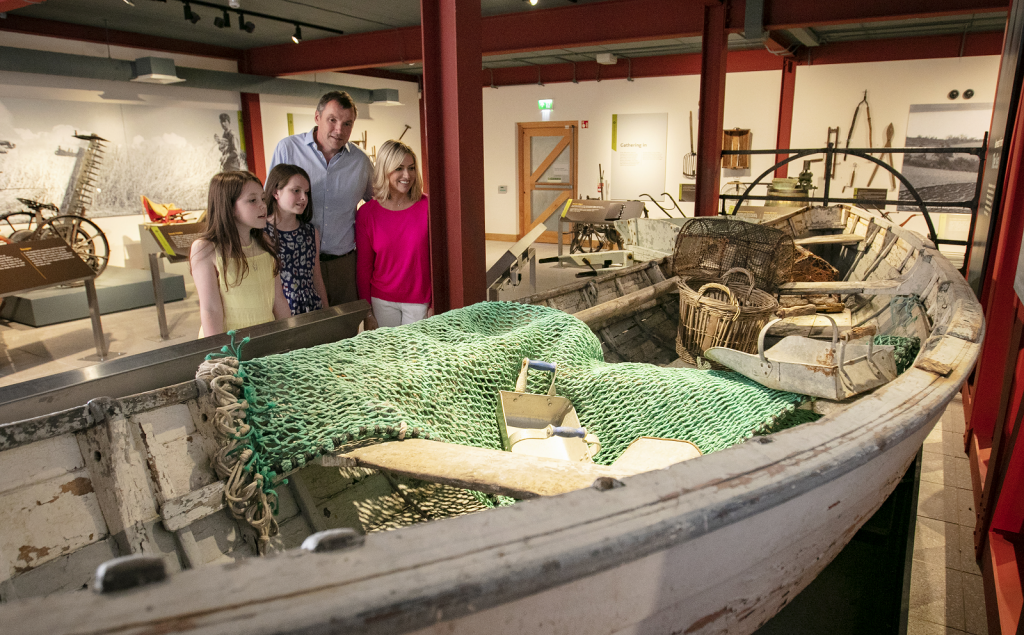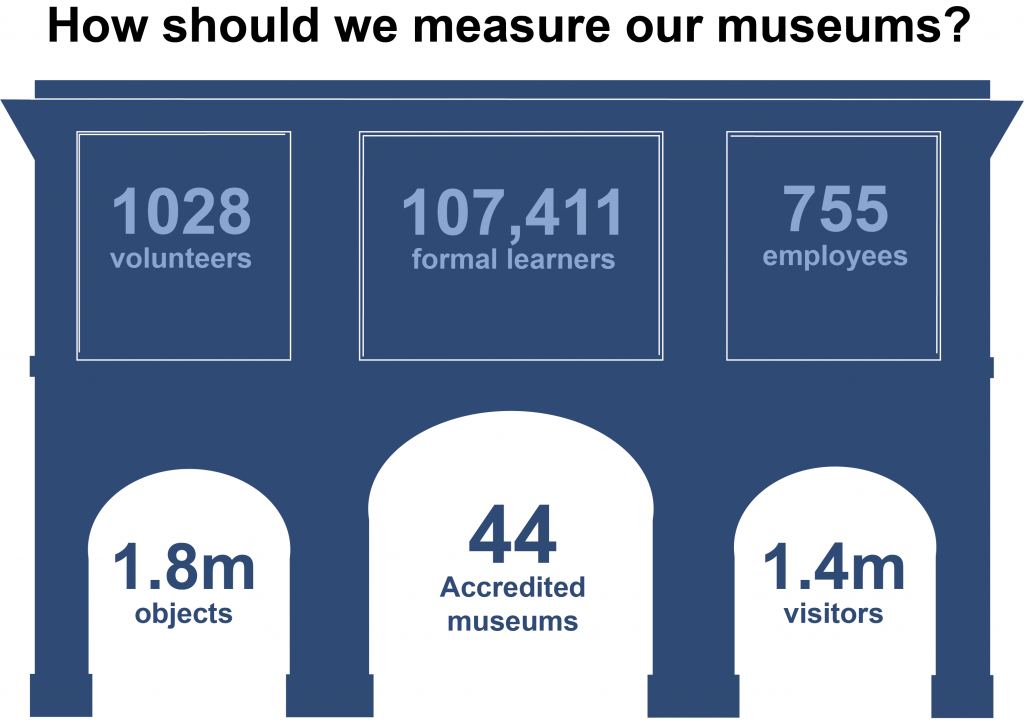Northern Ireland (NI) currently has 44 Accredited museums. But how does this compare with elsewhere and how should we go about assessing whether our museums are performing well? This article looks at some of the data we have available for museums and examines whether we are measuring the right things.

How many museums are there?
Generally, the standard by which an institution is recognised as a museum is if it has achieved Accreditation. There are 44 Accredited museums in NI. This means that per capita there is one Accredited museum for every 42,500 people in NI, compared with one per 42,300 people in England, one per 21,100 people in Scotland, and one per 31,900 people in Wales. In the Republic of Ireland, there is one MSPI-Accredited museum per 82,600 people, though as this scheme is relatively recent this figure may be subject to change.
NI has three national museums: the Ulster Museum, the Ulster Folk and Transport Museum, and the Ulster American Folk Park. It also has 21 local authority museums, ten independent museums, seven National Trust museums and three military museums. This is largely in proportion to the different museum types found throughout the UK, though the UK as a whole tends to have higher numbers of independent museums than local authority museums.
Quantity and type of collections
A survey of museum collections[1] in 2007 found that there are approximately 1.8 million objects and specimens held by Accredited museums in NI. This compares with 12 million in Scotland and 5.2 million in Wales. The majority of these 1.8 million items are held by national museums (1,446,187), with local authority museums holding 175,928, and independent museums 173,200. A number of resource pressures were identified by this survey: 81% of museums have not fully documented their collections and just 42% of museums described their stores as well organised and sufficient for their current collections.
More recent research on our local museums found that standards in environmental control, documentation of collections and security had declined. Twenty-four of the 39 museums surveyed indicated deficiencies in their storage arrangements. Indeed, these figures only include those objects which have been accessioned[2] and catalogued, and not those archaeological objects which have emerged from the ground as a result of excavations associated with development and construction since the 1990s but which have yet to find their way into a museum – these objects are largely still in the temporary care of the companies who excavated them.
Measuring standards
The Museums Accreditation Scheme which exists throughout the UK is designed to define good practice according to a minimum level of agreed standards, such as how the museum is run, how it manages its collections, and the experience of those using or accessing the museum. All museums seeking Accreditation must prove that they continue to meet the requirements of the scheme by sending an Accreditation return to the assessing organisation every two to three years. Museums Accreditation can also be a condition of funding. Some museums, such as Northampton Museums Service and Croydon Museum, have previously lost their Accreditation as a result of their local councils selling objects to raise money.
Number of visitors
Traditionally, visitor numbers have been seen as a key measure for museum performance. The latest year for which we have complete figures is 2015; these would suggest that visitor numbers have increased steadily at local museums over the last twenty years, reaching 636,952. When these figures for local museums are combined with a total of 798,067 visitors to NI’s national museums, there were a total of 1,435,019 museum visitors in 2015. This means that the average number of visitors per Accredited museum for that year was 34,167.
Survey evidence gathered by the Northern Ireland Museums Council highlighted concerns among museums about what performance data they should be recording. Indeed calls were made by the previous Committee for Culture, Arts and Leisure for there to be greater consistency and comparability in the capture and analysis of visitor data in museums.
On the basis of survey evidence, the UK-wide Understanding Society study concluded that in terms of the percentage of people who said they had visited a museum in the previous 12 months, Northern Ireland had the lowest level of attendance of the four regions.
Economic contribution of museums
There have been no overall assessments of the economic contribution of museums in NI since 2003. At that time, a Price Waterhouse Coopers report concluded that Accredited museums collectively attracted 800,000 visitors in 2001, of whom 152,000 were from outside the region. It was estimated at that time that total income amounted to around £17.3 million in 2000/01, and the total expenditure of the sector was around £16.2 million, of which 85% was spent in Northern Ireland.
Some local museums have taken steps to assess their own economic contribution. For example, Down County Museum used a toolkit created by the Association of Independent Museums to estimate their economic contribution in 2011. Using this toolkit, the museum concluded that it has a total gross visitor impact of £837,542 in the local economy, and that in terms of expenditure on supplies and services it had a total spend at the time of £149,666. Similar work has been done across all of NI’s local museums (i.e. not including the three national museums), with an estimated tourism impact for the sector as a whole at £9,077,651.

Educational contribution
In 2009, the Learning within Museums in Northern Ireland report found that 25 local museums in NI provided some form of curriculum-related resources and activities. However, the study also concluded that at the time relatively few museums put education at the core of their activities and more could be done to encourage museums to develop a learning policy for their institution. While this figure has risen to at least 31 museums, a 2016 report found that many museums would like to expand their educational activities but have ‘an identified lack of sufficient money and staff’.
Societal reach
In terms of who is visiting NI’s museums, an analysis of six of our local museums found that visitors are more likely to be female (with a 60/40% female/male split), that almost half of visitors were aged 55 and over, and that very small numbers of visitors were from ethnicity groups other than white. Just 8% of museum visitors across these six museums had a disability.
In terms of access by low income groups, survey data indicates that the proportion of residents from the most deprived areas who visit museums and science centres in NI is significantly lower (at 32%) than those from the least deprived areas (at 59%).
Are strategic priorities being achieved?
The museums themselves often have business plans which contain strategic objectives and linked performance indicators. For example, during 2016-17 National Museums Northern Ireland ‘worked towards 15 key performance indicators and 30 objectives‘ as set out in its Annual Business Plan under five themes ‘designed to drive public benefit for our audiences’. These performance indicators included things like the percentage of collections held in ‘acceptable, good or excellent conditions’, the number of objects loaned, and the number of specific initiatives targeted in areas of multiple deprivation. Indeed it was reported that 7,125 visiting children were from schools in the 20 most deprived areas.
In addition to the three National Museums, NI has 21 local authority museums. Each local council has a duty, under the Local Government Act (NI) 2014, to set improvement targets, and these often contain elements which relate to museums. For example, the Performance Improvement Plan 2018/19 for Armagh City, Banbridge and Craigavon Borough Council has three objectives with relevance for its museums, that it will ‘provide and promote more opportunities for people to improve their physical, mental and social wellbeing’, ‘improve economic growth across the Borough’, and ‘develop and promote the built, natural and cultural heritage, creating vibrant and attractive urban and rural areas’. The plan states that it will measure success over the next year by monitoring the number of users and participants, and gauging these as a percentage of its overall population. A number of local authority museums use Association for Public Service Excellence monitoring to record numbers of active participants, users and the total income and expenditure on such activities.
But beyond these local level examples, how do we assess the performance of NI museums as a whole? The draft Programme for Government consultation contained no specific mention of museums or heritage, though it does contain a more general reference (in indicator 27) to improving ‘cultural participation’. A short-term Outcomes Delivery Plan published in June of this year also contains nothing specific on museum performance, though ‘Outcome 5′ has as one of its indicators the ‘% engaging in arts/cultural activities’, and it is indicated that ‘a series of activities will seek to increase this engagement further by 2020-2021, equating to around 30,000 individuals’.
The Northern Ireland Museums Policy
Going deeper than the relatively broad-brush measures already cited, how might we measure the extent to which museums are achieving their intended social, economic and cultural purposes?
Back in 2011, the former Department of Culture, Arts and Leisure published a Museums Policy for Northern Ireland with four strategic priorities: developing audiences; education and learning; collections development, care, management and use; and infrastructure, investment and resources. Each of these contain a set of goals, such as ‘to increase the number and diversity of people visiting NI’s museums’, ‘to ensure that high quality museum learning services are consistently available across Northern Ireland’, and ‘to develop museums’ capacity to deliver and support high quality research on and around their collections’. But it is not clear to what extent this policy is still being used as the prism through which museums are viewed and measured in Northern Ireland, nor the extent to which the policy is still regarded as ‘active’.
Since 2011, there have been no published assessments of the performance of NI’s museums against the strategic priorities within the policy. This stands in contrast to extensive recent reviews of museums in England, and also in Wales (both for local and national museums). While it would appear that we have lots of data to measure our museums, some of it is quite old now and this prompts a number of questions, chief among these being what are we measuring, and why? What is the correct measure of ‘success’ for a public museum and what are the policy makers responsible for museums in NI aiming to achieve?
______________________
[1] Northern Ireland Museums Council. 2007. Survey of Museum Collections in Northern Ireland. Belfast.
[2] ‘Accessioning’ is a term used to refer to an object which is permanently and formally included within a museum’s collection.

